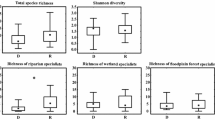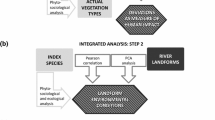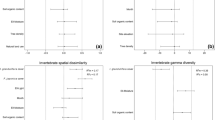Abstract
We investigated the influence of channel migration and expansion on riparian plant species diversity along the lower Colorado River near the United States–Mexico border. Using repeat aerial photography in a GIS we identified and classed areas of low, moderate, and high disturbance frequency caused by channel expansion and migration. Replicate vegetation plots (12 m × 12 m) were sampled in each of the three disturbance classes. One-way ANOVA was used to test for differences in species richness, species diversity (using the Shannon–Weiner Index) and overall percent ground cover of plants between the three disturbance classes. Regardless of disturbance class, plots were dominated by trees or shrubs, especially the non-native Tamarix ramosissima, as well as Pluchea sericea, Baccharis salicifolia and Salix goodingii. Clearly woody species constitute the great bulk of overall species richness, percent ground cover, and species diversity (H′) in each disturbance group. No overall statistically significant differences were revealed among the disturbance groups for values of species richness, percent ground cover, or the Shannon–Wiener Index, though paired contrasts of means revealed that total percent ground cover on low disturbance plots was significantly higher than on moderately disturbed plots. Spatial and temporal variability in riparian diversity in the study area appears to hinge on factors other than disturbance frequency such as salt or drought stress. Alternately, our results could be interpreted as suggesting that in the presence of intensive flow regulation, disturbance plays a secondary role to ecological stresses, similar to that demonstrated by others. Intentional flood pulses are advocated as a restorative management strategy for improving plant productivity, management of exotic species (particularly T. ramosissima), and restoration of overall biodiversity.
Similar content being viewed by others
References
W.L. Baker G.M. Walford (1995) ArticleTitleMultiple stable states and models of riparian vegetation succession on the Animas River Colorado Annals of the Association of American Geographers 85 320–338
W.J. Barnes (1997) ArticleTitleVegetation dynamics on the floodplain of the lower Chippewa River in Wisconsin Journal of the Torrey Botanical Club 124 189–197
J. Bendix (1997) ArticleTitleFlood disturbance and the distribution of riparian species diversity The Geographical Review 87 468–483
C.D. Bonham (1989) Measurements for Terrestrial Vegetation John Wiley & Sons New York
M.K. Briggs S. Cornelius (1998) ArticleTitleOpportunities for ecological improvement along the lower Colorado River and delta Wetlands 18 513–529
D.E. Busch S.D. Smith (1995) ArticleTitleMechanisms associated with decline of woody species in riparian ecosystems of the southwestern U.S. Ecological Monographs 65 347–370
S.A. Cain G.J.de O. Castro (1959) Manual of Vegetation Analysis Harper New York
CIMIS 2002. California Irrigation Management Information System. Imperial Valley Data, www.dpla. water.ca.gov/cimis/cimis/hq/1-2002
M.J. Cohen C. Henges-Jeck G. Castillo-Moreno (2001) ArticleTitleA preliminary water balance for the Colorado River Delta1992–1998 Journal of Arid Environments 49 35–48
J.H. Connell (1978) ArticleTitleDiversity in tropical rainforests and coral reefs Science 199 1302–1310 Occurrence Handle17840770
C.M. Cowell J.M. Dyer (2002) ArticleTitleVegetation development in a modified riparian environment: human imprints on an Allegheny River wilderness Annals of the Association of American Geographers 92 189–202
H. Decamps E. Tabacci (1992) Species richness in vegetation along river margins P.S. Giller A.G. Hildrew D.G. Hildrew (Eds) Aquatic Ecology: Scale Pattern and Process Blackwell Scientific Publications OxfordUK 1–20
A.F. Deiller J.N. Walter T. Tremolieres (2001) ArticleTitleEffects of flood interruption on species richness, diversity and floristic composition of woody regeneration in the Upper Rhine alluvial hardwood forest regulated rivers Research and Management 17 393–405
E.P. Glenn C. Lee R. Felger S. Zengel (1996) ArticleTitleEffects of water management on the wetlands of the Colorado River Delta Mexico Conservation Biology 10 1175–1186
E. Glenn R. Tanner S. Mendez T. Kehret D. Moore J. Garcia et al. (1998) ArticleTitleGrowth rates, salt tolerance and water use characteristics of native and invasive riparian plants from the delta of the Colorado River Mexico Journal of Arid Environments 40 281–294
E.P. Glenn F. Zamora-Arroyo P.L. Nagler M. Briggs W. Shaw K. Flessa (2001) ArticleTitleEcology and conservation biology of the Colorado River DeltaMexico Journal of Arid Environments 49 5–15
W.L. Graf (2000) ArticleTitleLocational probability for a dammed urbanizing stream: Salt River Arizona, USA Environmental Management 25 321–335 Occurrence Handle10629313
A.M. Gurnell (1995) Vegetation along river corridors: hydrogeomorphological interactions changing river channels A.M. Gurnell G.E. Petts (Eds) Changing River Channels John Wiley and Sons ChichesterUK 237–260
J.C. Hickman (Eds) (1993) The Jepson Manual Higher Plants of California University of California Press Berkeley, California
M. Huston (1979) ArticleTitleA general hypothesis of species diversity The American Naturalist 113 81–101
M. Huston (1994) Biological Diversity Cambridge University Press CambridgeUK
W.C. Johnson (2000) ArticleTitleTree recruitment and survival in rivers: influence of hydrological processes Hydrological Processes 14 3051–3074
B.E. Kus (1998) ArticleTitleUse of restored riparian habitat by the endangered Bell’s vireo Restoration Ecology 6 75–82
D. Luecke J. Pitt C. Congdon E. Glenn C. Valdes-Casillas M. Briggs (1999) A Delta Once More: Restoring Riparian and Wetland Habitat in the Colorado River Delta Environmental Defense Fund Publications Washington, DC
R.L. Mackey D.J. Currie (2001) ArticleTitleThe diversity–disturbance relationship: is it generally strong and peaked? Ecology 82 3479–3492
A.E. Magurran (1988) Ecological Diversity and Its Measurement Princeton University Press Princeton, New Jersey
G.P. Malanson (1993) Riparian Landscapes Cambridge University Press Cambridge, UK
J.C. McGrew C.B. Monroe (2000) An Introduction to Statistical Problem Solving in Geography McGraw-Hill Boston, Massachusetts
E. Muller (1997) ArticleTitleMapping riparian vegetation along rivers: old concepts and new Methods Aquatic Botany 58 411–437
R.J. Naiman H. Decamps M. Pollock (1993) ArticleTitleThe role of riparian vegetation in maintaining regional biodiversity Ecological Applications 3 209–212
C. Nilsson G. Grelsson M. Johansson U. Sperens (1988) ArticleTitleCan rarity and diversity be predicted in vegetation along river banks? Biological Conservation 44 201–212
C. Nilsson G. Grelsson M. Johansson U. Sperens (1989) ArticleTitlePatterns of species diversity along riverbanks Ecology 70 77–84
C. Nilsson M. Ekbland M. Gardfjell B. Carlberg (1991) ArticleTitleLong-term effects of river regulation on river margin vegetation Journal of Applied Ecology 28 963–987
D.T. Patten (1998) ArticleTitleRiparian ecosystems of semi-arid North America: diversity and human impacts Wetlands 18 498–512 Occurrence Handle10.1007/BF03161668
J. Pitt D. Luecke M. Cohen E. Glenn C. Valdes-Casillas (2000) ArticleTitleTwo nations, one river: managing ecosystem conservation in the Colorado River Delta Natural Resources Journal 40 819–865
N.L. Poff J.D. Allan M.B. Bain J.R. Karr K.L. Prestegaard B.D. Richter et al. (1997) ArticleTitleThe natural flow regime Bioscience 47 769–784
M.M. Pollock R.J. Naiman T.A. Hanley (1998) ArticleTitlePlant species richness in riparian wetlands – a test of biodiversity theory Ecology 79 94–105
C.E. Shannon W. Wiener (1949) The Mathematical Theory of Communication University of Illinois Press Urbana, Illinois
InstitutionalAuthorNameSPSS (1999) SYSTAT 9 SPSS Inc. Chicago, Illinois
J.C. Stromberg (1998) ArticleTitleDynamics of Fremont cottonwood (Populus fremontii) and salt Cedar (Tamarix chinensis) populations along the San Pedro RiverArizona Journal of Arid Environments 40 133–155
J.C. Stromberg (2001) ArticleTitleRestoration of riparian vegetation in the southwestern United States: importance of flow regimes and fluvial dynamism Journal of Arid Environments 49 17–34
J.C. Stromberg M.K. Chew (2002) Flood pulses and restoration of riparian vegetation in the American Southwest B.A. Middleton (Eds) Flood Pulsing in Wetlands: Restoring the Natural Hydrological Balance John Wiley and Sons New York 11–49
J.C. Stromberg R. Tiller B. Richter (1996) ArticleTitleEffects of groundwater decline on riparian vegetation of semiarid regions: the San Pedro River Ecological Applications 6 113–131
G. Sykes (1937) The Colorado Delta Kennikat Port Washington, New York
Tiegs S.D. and Pohl M. Planform channel dynamics of the lower Colorado River: 1976–2000. Geomorphology (in-press).
P. Unitt (1987) ArticleTitleEmpidonax traillii extimu: an endangered subspecies Western Birds 18 137–162
InstitutionalAuthorNameUSGS (1989) Guide for Selecting Manning’s Roughness Coefficients for Natural Channels and Flood Plains United States Geological Survey Water-Supply Paper 2339 USGS, DenverColorado
M.W. Vandersande E.P. Glenn J.L. Walworth (2001) ArticleTitleTolerance of five riparian plants from the Lower Colorado River to salinity, drought and inundation Journal of Arid Environments 49 147–159
J.V. Ward (1998) ArticleTitleRiverine landscapes: biodiversity patterns, disturbance regimes and aquatic conservation Biological Conservation 83 269–278
F. Zamora-Arroyo P.L. Naglel M. Briggs D. Radtke H. Rodriquez J. Garcia et al. (2001) ArticleTitleRegeneration of native trees in response to flood releases from the United States into the delta of the Colorado RiverMexico Journal of Arid Environments 49 49–64
J.H. Zar (1999) Biostatistical Analysis EditionNumber4th edn Prentice Hall Upper Saddle RiverNew Jersey
Author information
Authors and Affiliations
Corresponding author
Rights and permissions
About this article
Cite this article
Tiegs, S.D., O’leary, J.F., Pohl, M.M. et al. Flood disturbance and riparian species diversity on the Colorado River Delta. Biodivers Conserv 14, 1175–1194 (2005). https://doi.org/10.1007/s10531-004-7841-4
Received:
Accepted:
Issue Date:
DOI: https://doi.org/10.1007/s10531-004-7841-4




